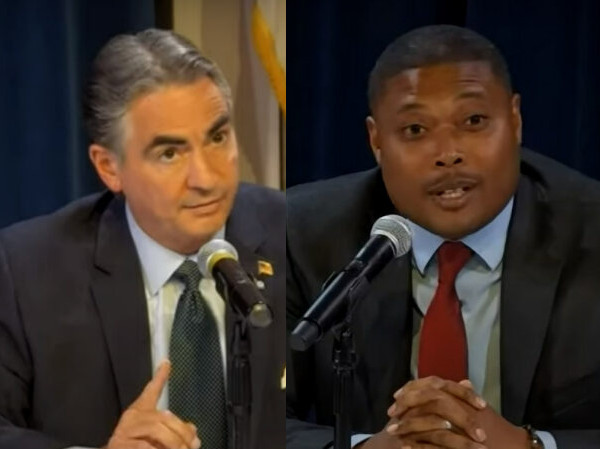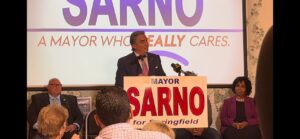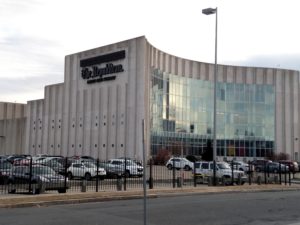Top Six Takeaways from the Preliminary for the City Founded in 1636…
SPRINGFIELD—Mayor Domenic Sarno and City Councilor Justin Hurst’s advancement to the mayoral preliminary was the result the city’s chattering classes had been expecting for nearly a year. However, a reductionist understanding of what happened risks missing real lessons in the wake of the election.
Here are some key takeaways from Tuesday.
- Money mattered, but not how you think.
Hurst raised the most of the challengers, but he frequently had less cash-on-hand than State Rep Orlando Ramos due to the latter’s carryover fundraising from last year. While some of his spending likely had little to no impact, he spent it over time more like Lederman did.
In short, Hurst had the funds to build upon the extant assets he had over 10 years on the Council. He got on radio and TV, sent out mailers and could even afford some staff. It was enough.
- Having a ton of money did not matter
This was most especially true for the SuperPAC adult care services mogul Cesar Ruiz funded, Hispanic Latino Leaders Now.
Cesar Ruiz:
💵
🔥#mapoli #spfldpoli— Matt Szafranski (@MSzafranski413) September 13, 2023
While a breakdown of its specific Ramos spending is difficult to know given HLLN’s incomprehensible filings, it ran the gamut of campaign messaging. Texts, billboards, ads, mailers—you name it. Perhaps it had some success boosting Jose Delgado and Brian Santaniello—who works for/with Ruiz. But it fundamentally failed in what became its principal mission of supporting Ramos.
However, Sarno also blew a massive chunk of cash and it still couldn’t get him to 50%. Since January 1, Sarno has spent $389,630. It got him fewer votes than he won in the 2011 preliminary when he spent considerably less, even adjusted for inflation. The campaign spent $193,000 in August alone. Not only did he overspend, many donors have tapped out already.
Hurst has a long way to go to match the 86 grand Sarno ended August with, but for the price Sarno paid he should have gotten a more comfortable win.
- Getting in early made a difference.
Latino turnout was nowhere near that community’s share of the population. Thus, Black voters became the demographic to watch, as Sarno romped in whiter precincts. But it may be too early to frame this in identitarian grounds.
Hurst’s early announcement—November 30 last year—triggered a big Sarno fundraising surge in December. It also cemented a lot of anti-Sarno votes for Hurst. Some erstwhile supporters of both Council President Jesse Lederman and Ramos signed up with Hurst.
Black voters may not have rallied to Hurst because he was Black. They rallied to him because he was credible. Hurst is not Barack Obama, but the former president offers a lesson. Early on, Hillary Clinton was outpolling Obama among Black voters in crucial states like South Carolina until she wasn’t. What changed? Obama began to catch fire and eventually won Iowa. The rest is history.
4. Turnout Was Abysmal and Amazing at the Same Time
According to unofficial results, nearly 15,000 people voted in Springfield’s mayoral preliminary. This is a hair under the raw general election turnout in 2019 and twice that year’s preliminary turnout. Obviously, having three sitting elected officials challenge the mayor helped.
Nevertheless, this amounted to not even 15% of registered voters. The percentage can be a bit deceiving because Springfield has for nearly 20 years had very good voter registration data. Turnout in presidential years experienced a boost during and after the Obama era. Municipal election turnout has not really improved.
Even assuming another 5,000 voters (at least show up in November), consistent with precedent, this means not even 15% of the city will choose its mayor. Not even 15% will decide the fate of nearly a billion in public spending or who sets the agenda for the city.
This is to say nothing about the poor turnout among Hispanics, the larges Census cohort in the city. Their disproportionately small presence may not have been decisive for Ramos, but it may have weakened some of the Latinos running for City Council.
5. The Emaciation of Springfield Media Is Hurting Politics
Much as Mayor Sarno may prefer otherwise, this election cycle has been one of the most intense in years. The size of the field, the sums spent and the portrayal of the stakes exceed that of Sarno’s last real fight in 2011. The appropriate parallel may be when Sarno prevailed over Charlie Ryan in 2007.
You would know almost none of this unless you were a campaign volunteer, knew a candidatte personally, or owned real estate like a barstool at the City Line Café.
Some media did try.
But the outlets with the broadest reach—Masslive/The Republican and the TV stations—shrank in the face of this opportunity. Reporting on candidates, other than their kickoffs and errant controversies, was minimal and rarely in-depth. Lies, overstatements, and misdirection could lie unmolested, ostensibly to bow at the alter at the laziest objectivity: fact-check avoidance or bothsidesism. To WWLP’s credit, they did hold a forum, but they did not flex any muscle to compel Sarno’s attendance.
The cost is people do not even recognize their city. Other than tropes about crime, many city voters have no real insight into the city’s problems. Certainly racists and ninnies fearful of change contributed to the Putinesque margins Sarno enjoyed in wealthier neighborhoods. Yet, a more decisive factor is people have no broad understanding of how the other half lives nor the true state of the city.
- It is going to get nasty
If you’re looking for sunshine, lollipops and rainbows in this election, you may find it in the Council races. It will not exist in the mayoral race.
While Sarno supporters have tried to spin the results as a super-happy-fun time from here on out, it is anything but. Sarno is a wounded beast, a harpooned whale, but not a beached one. He will lash out if things continue to look tight. The mayor’s office has a thick oppo file on Hurst.
But Hurst is not without ammo, either. Of the four challengers, he went for the mayor’s jugular most directly. The tactic plainly did not cost him much, at least in the preliminary. A competitive race will encourage still more to damning factoids to get out there and onto social media and ads, if not the press.
The ride has only begun, folks.



